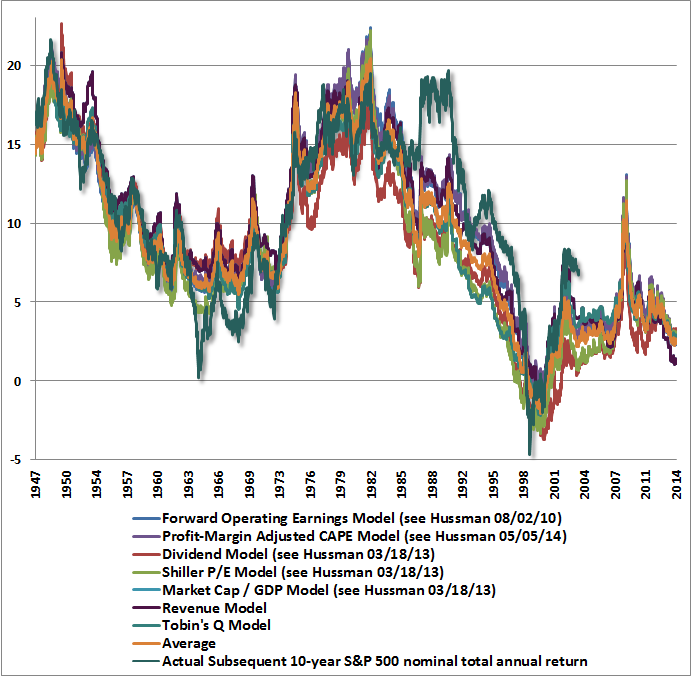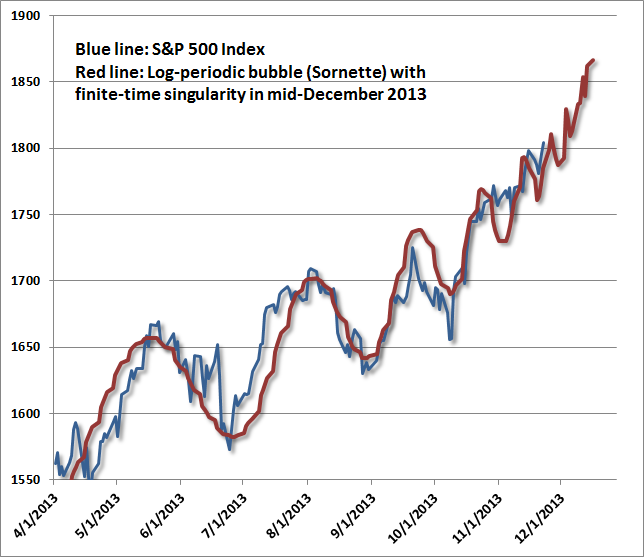Hussman Funds Experimenting with the Market s Median Valuation
Post on: 15 Июль, 2015 No Comment

Experimenting with the Market’s Median Valuation
A view from the perspective of the typical stock
William Hester, CFA
July 2008
All rights reserved and actively enforced.
Nailing down a proper valuation for the S&P 500 is particularly challenging at this point in the cycle. The many moving parts of a P/E ratio are fluctuating a lot. Reported trailing earnings are in decline, spurred in part by contracting profit margins. The economy has slowed to a crawl, limiting companies’ abilities to grow domestic sales. And stock prices, while generally moving lower, have chosen a volatile route in that direction.
Market P/E ratios based on trailing earnings offer up other challenges. Stock prices are nearly sure to rise before profits trough, which will send P/E’s spiking higher. Even P/E’s based on averaged earnings – such as Professor Robert Schiller’s which uses earnings averaged over the prior decade — may be currently misleading. This ratio may end up overstating the attractiveness of stocks because it’s counting a chunk of earnings from the financials group that has since disappeared and is unlikely to return soon. Plus, if record profit margins of the last few years prove unsustainable, then recent earnings figures may be overstating the true earnings power for the index.
A separate and more manageable task than valuing ‘the market’ may be to ask to what extent the valuation of the “typical” stock has improved. The question posed this way isn’t helpful to investors in index funds, but for others it may help to determine whether there are stock selection opportunities within the market, especially when compared with previous market declines. One of the ways we can do this is to take the median valuation of the companies in the S&P 500 Index (that is, the P/E at which half the stocks have higher valuations and half have lower valuations). The graph below shows the S&P 500’s median P/E ratio going back to the early 1970’s.
As the chart shows, the median P/E is not a very useful tool for valuing the overall market. During the Tech bubble the S&P 500’s median P/E reached 23, far less than the index’s overall P/E of 33. Even so, the median P/E ratio of 23 tempered the “overvalued” message sent by the largest stocks with heaviest weights, and suggested that there were still individual stocks with more reasonable valuations.
The ratio does give clues about how the average stock is valued. The median P/E ratio for the stocks in the S&P 500 fell below 15 last week, a level it had also reached at the market’s bottom in 2002. The median P/E ratio has fallen from about 19 times earnings last year this time, which indicates a clear improvement in the valuation of the typical stock in the index. The ratio relays a similar message that other valuation metrics do: stocks are generally better valued than they were during the late 90’s bubble and most years since, but the typical stock’s valuation is still well above previous bear market bottoms. In 1990-1991, when the U.S. economy was in recession and working through a (much more contained) banking crisis, the S&P’s median P/E ratio fell to 11. In 1982 the ratio was at 7 and in 1974 it fell to 5.
Of course, taking the index’s median P/E ratio doesn’t solve all of the issues that plague the overall P/E. The median stock may be unjustly attractive if profit margins are far above sustainable levels. The graphs below show the S&P 500’s median price-to-sales (P/S) ratio, which sidesteps the earnings data by using sales (this series is estimated by taking the current members of the index and taking the median ratios historically).
Based on this measure, the valuation of the typical stock has not yet reached the levels of 2002. This is different from what we observe for P/E ratios, because profit margins are still elevated compared with prior periods. The median P/S ratio of the S&P 500 is 1.30 versus 1.17 in 2002. The current ratio of 1.30 sits above the long-term average of 1.14 since 1975 and the median of 1.10. At the low of the 1990 bear market the ratio reached 0.77 and in the early 1980’s it fell below 0.50.
While most stocks are punished during bear markets, the real damage is often concentrated in certain groups, like Technology stocks in 2002 and the Nifty Fifty stocks in 1974. This time it’s been the S&P 500 Financial Index, which is down 44 percent over the past year, and the Consumer Discretionary Index which has fallen almost 30 percent. Both groups track a broad cross-section of stocks. The Financial Sector includes diversified financials, banks, insurance, and real estate companies. The Consumer Discretionary Sector includes autos, appliance makers, home builders, retail, and media companies.
When we extend the median valuation analysis to sectors, it gives a sense of the improvement in valuation by sector. Not surprisingly, the two groups that have declined by the greatest amount have the most dramatic looking valuation charts. The charts below show the median P/S ratio for the Financials Index and the Consumer Discretionary Index, respectively.
One way to estimate the current valuation of each group relative to its historical range is to compare the most recent median P/S ratio to its own long-term median. When we do this the Consumer Discretionary group is trading 22 percent below its long-term median, which is the largest discount of the ten sectors. The Financial sector trades at about a 10 percent discount to its median. Energy, Industrials and Consumer Staples groups are all trading the farthest above their long-term medians.

Adjusted Sector Valuations
We can approach measuring the risk among sectors a different way, especially if we are concerned about profit margins continuing to revert toward long-term averages. Specifically, we can adjust each sector’s current valuation by the extent that margins within these sectors have risen above long-term averages. One way of doing this would be to assume that for each individual company, the median profit margin over the prior decade was a good estimate of a sustainable margin. This wouldn’t work in every case, but it should provide some amount of insight when applied to a larger group of companies. We can then use this median margin to back out “adjusted” or “normalized” earnings, and then assess the valuation on those earnings.
For example, L-3 Communications had the S&P 500’s median P/E at one point this week. Over the past decade the security services provider’s profit margins have generally drifted upward from about 3 percent in 1998, to 4.5 percent in 2002, to 5.4 percent most recently. The most recent profit margin sits on the upper end of the range for the company and earnings are at a record level, fueled partly by the increase in defense spending this decade. By applying the company’s medium profit margin to recent sales, current earnings drop by about 14 percent. The P/E ratio on this ‘normalized earnings’ number climbs to 17.2 from 14.8. Of course, not all stocks look expensive relative to their reported earnings. Home Depot’s profit margin has shrunk in recent years as it battles competitors and a slowing economy. The company’s adjusted P/E ratio is 8.8 versus a reported P/E ratio of 10.8.
Using this method I calculated the P/E ratio for each of the stocks in the S&P 500. In place of calling it “the ratio of price to earnings normalized by the median profit margin over the prior decade,” we’ll just refer to it as the normalized P/E ratio. The median of these normalized P/E ratios is currently 16. This compares with the median reported P/E ratio of 14.9. Although the first graph above shows the unadjusted median P/E ratio for the S&P, it depicts roughly where the current normalized P/E ratio stands as well: slightly above the long-term averages but still at a much improved level when compared with the 2004 – 2007 period.
The chart below takes this method of analysis and applies it to the S&P’s ten sectors. Each red bar shows the current median normalized P/E ratio for each sector. The blue bars show each sectors median reported P/E ratio. So for example, the Materials group’s red bar denotes the median normalized P/E ratio for all of the stocks within that sector. The group’s blue bar represents the median traditional P/E ratio. The sectors are ranked top to bottom by the difference between their reported P/E ratio and normalized P/E ratio.
The chart shows that there are important differences between normalized P/E ratios and reported P/E ratios for sectors within the S&P. The median reported P/E ratio for the Materials sector is 13.2, while on a normalized basis it’s nearly 22. The energy group’s median reported P/E ratio is 16.2 versus 22.9 on an adjusted basis. The Telecommunication Services and Industrials sectors also appear to be more expensive than reported P/E ratios suggest. Health Care and Information Technology are slightly more expensive than traditional P/E’s. The reported P/E’s of the Financials, Consumer Discretionary, and Utilities Sectors seem to be about right based on normalized profit margins (though Financials clearly have additional risks here). Consumer Staples may represent better value than reported P/E’s imply.
Applying the same process to the S&P 500’s 24 industries shows similar results. Materials, Energy, and Telecommunication Services have adjusted P/E ratios that are farthest above their reported P/E’s. Companies in the Insurance, Capital Goods, and Health Care Equipment & Services groups are next on the list. The groups with P/E ratios farthest below their reported P/E ratios include: Real Estate, Consumer Services (hotels, fast-food restaurants, high-end coffee shops, etc.), Banks, Consumer Durables & Apparel, and Household & Personal Products.
To sum up, the S&P 500’s median P/E ratio, now at 14.9, has fallen to just above its long-term average (14) and below its own median (15). It’s near the valuation levels reached in 2002, but remains noticeably above the levels reached in 1991 (11) and the bear markets ending in 1982 (7) and 1974 (5). On a margin-adjusted basis the S&P’s median P/E ratio (16) is slightly more expensive than on a reported basis. When looking at the median stock in each sector, the Financials and Consumer Discretionary groups are trading at valuation levels not seen since the early 1990’s. Consumer Discretionary stocks are trading at the largest discount to their median P/S ratio. Lastly, while the valuation of the overall market has improved, this analysis shows that the adjusted P/E ratios of the market’s most favored groups — including materials, energy, and industrial stocks – sit far above their reported P/E ratios.














